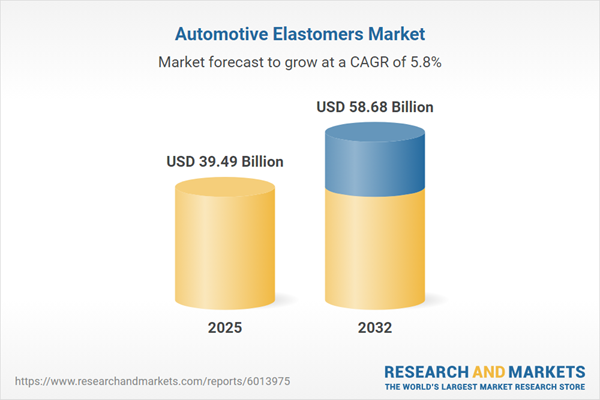Speak directly to the analyst to clarify any post sales queries you may have.
Senior automotive decision-makers are navigating rapid transformation in the automotive elastomers market, with regulatory, technological, and supply chain factors introducing new complexities. This report offers critical market intelligence and practical guidance tailored for leaders charting the future of material strategy in the automotive industry.
Market Snapshot: Automotive Elastomers Market Size and Growth Trajectory
The automotive elastomers market is valued at USD 37.29 billion in 2024, projected to reach USD 58.68 billion by 2032 with a compound annual growth rate (CAGR) of 5.83%. Growth is driven by wider applications of elastomer materials across vehicle categories and the integration of innovative compounds. Current trends point to a transition toward advanced material sciences, which enhance component reliability and align with evolving compliance standards. Manufacturers are adapting to more intricate global supply chains while prioritizing high-performance elastomer solutions to secure competitive advantage and operational stability.
Scope & Segmentation: Strategic Insights for Automotive Elastomers Market Leaders
- Distribution Channels: Aftermarket and OEM supply chains each play an integral role in supporting resilience, ensuring reliable elastomer delivery, facilitating regulatory adherence, and addressing diverse customer sourcing needs.
- Vehicle Types: Elastomers are deployed across commercial vehicles, off-highway equipment, passenger cars, and two-wheelers, with each vehicle segment presenting unique performance and durability requirements for optimal efficiency and safety.
- Applications: Use cases include hoses, belts, seals, gaskets, tires, and vibration control. Strategic application of elastomers can heighten vehicle safety, lengthen operational lifespan, limit maintenance needs, and boost occupant comfort.
- Product Types: Butyl, chloroprene, EPDM, nitrile butadiene, and styrene butadiene are essential material types, supporting design objectives for durability, efficient assembly, and consistent performance across service cycles.
- Regional Analysis: North America, Latin America, Europe, the Middle East, Africa, and Asia-Pacific each require region-specific sourcing and operational strategies, reflecting their diverse regulatory landscapes and supply chain environments.
- Technology & Market Players: Innovation in elastomer development is led by organizations such as China Petroleum & Chemical Corporation, Kumho Petrochemical, JSR Corporation, LANXESS AG, Dow Inc., Exxon Mobil, Asahi Kasei, Versalis S.p.A., Denka, and ZEON Corporation, shaping global standards and accelerating adoption across automotive segments.
Key Takeaways: Strategic Trends in the Automotive Elastomers Market
- Lightweight elastomer solutions support automakers’ evolving sustainability and efficiency targets, helping align with changing regulatory frameworks and market expectations.
- Compound advances improve insulation and noise reduction, offering enhanced value in electric and autonomous vehicles as consumer demand grows for higher comfort standards.
- Regional supply agility is vital; manufacturers that adapt sourcing strategies remain resilient against global trade fluctuations and supply chain disruptions, optimizing cost control.
- The move toward recyclable and bio-based elastomers reflects industry-wide commitment to environmental compliance, enabling future-adaptive product portfolios.
- Collaboration between manufacturers and market players expedites bespoke elastomer solutions, meeting specific needs for OEMs and aftermarket customers and improving sector competitiveness.
- Differentiation by vehicle category underlines flexibility in fulfilling technical, reliability, and service-life requirements across passenger, commercial, and specialty vehicles.
Tariff Impact: Regulatory Pressures Reshape Sourcing and Competitiveness
Recent U.S. tariff adjustments have made sourcing strategies more dynamic, reinforcing the importance of domestic partnerships and compliance management. As standards tighten, leaders focus on advanced material chemistries, supplier diligence, and procurement planning to secure resilient supply chains and cost stability.
Methodology & Data Sources
This automotive elastomers market analysis synthesizes executive interviews, comprehensive case studies, and validated quantitative research. Rigorous scenario modeling and independent peer review provide leaders with reliable insights for strategic actions in evolving market conditions.
Why This Report Matters for Senior Decision-Makers
- Structured analysis enables proactive response to regulatory, supply chain, and technology changes impacting the automotive elastomers landscape.
- Granular segmentation by product, region, and application informs investment, resource deployment, and organizational strategy for resilience and adaptability.
- Leverage research-driven insights to drive sustainable organizational performance as the automotive sector evolves around material innovation and compliance demands.
Conclusion
This report equips senior executives with actionable market intelligence for steering strategic decisions in the automotive elastomers sector, empowering organizations to optimize performance and capture new opportunities in a changing landscape.
Additional Product Information:
- Purchase of this report includes 1 year online access with quarterly updates.
- This report can be updated on request. Please contact our Customer Experience team using the Ask a Question widget on our website.
Table of Contents
3. Executive Summary
4. Market Overview
7. Cumulative Impact of Artificial Intelligence 2025
Companies Mentioned
The companies profiled in this Automotive Elastomers market report include:- China Petroleum & Chemical Corporation
- Kumho Petrochemical Co., Ltd.
- JSR Corporation
- LANXESS AG
- Dow Inc.
- Exxon Mobil Corporation
- Asahi Kasei Corporation
- Versalis S.p.A.
- Denka Company Limited
- ZEON Corporation
Table Information
| Report Attribute | Details |
|---|---|
| No. of Pages | 182 |
| Published | November 2025 |
| Forecast Period | 2025 - 2032 |
| Estimated Market Value ( USD | $ 39.49 Billion |
| Forecasted Market Value ( USD | $ 58.68 Billion |
| Compound Annual Growth Rate | 5.8% |
| Regions Covered | Global |
| No. of Companies Mentioned | 11 |









